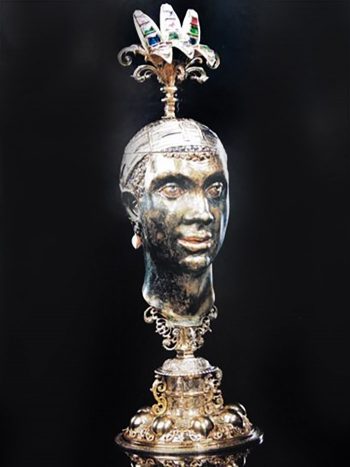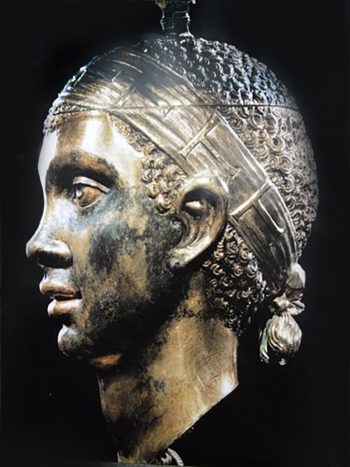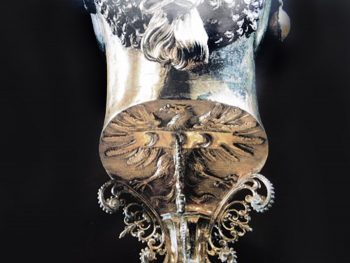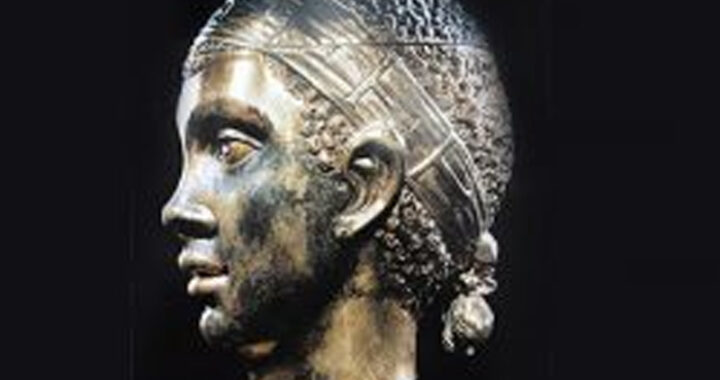James Lowe, Silver Specialist
Download this article

Sadly, the first photo does not show my country retreat – it is the Schloss Moritzburg, about 10 miles from Dresden and was the country seat of the Dukes of Saxony. It was built around 1750, primarily to house their fabulous collection of art and works of art and it’s where my chosen piece of silver spent a couple of hundred years. I have chosen this piece because it is a true tour de force of the silversmith’s skills and has had an extraordinarily romantic and eventful history.

It is a Marriage Cup, about 50 cms high, made in silver gilt by Christoph Jamnitzer (image supplied) in Nuremburg around 1615. Topically controversial, the subject is a Blackamoor – one of thousands of North Africans brought into the region to work as servants on the estates of the wealthy European families of the period. The name of the subject is not known, but the bust represents the central feature of the coat of arms of the fabulously wealthy Pucci family of Florence, and was made to commemorate a Pucci family member marrying one of the equally wealthy Strozzi family.

The head up to his crown would have been hand raised from a single disc of silver – hammered into shape with thousands of very skilfully struck blows to form the likeness we can see here. It would have been mercury gilded and was originally partially painted black – some of which has worn away over the years. The top of his head was another hammered-up disc and very realistically chased with curled hair and topped with an extravagantly plumed head dress set with coloured crystals.

He has a single pierced ear and wears a pearl drop earring. The ‘chopped – off’ back of his neck is beautifully chased and engraved with the coat of arms of the Strozzi family. The base would have been spun up on a lathe from another disc of silver and laboriously and fabulously skilfully chased, engraved, and embossed with scroll work. The bust is supported and strengthened with cast silver gilt scroll brackets embellished with flowerheads.
Back to Schloss Moritzburg. In 1945, the Royal family had for many years been harried by the Nazis, and with the imminent arrival of the Russians, two of the elder Princes decided to hide much of their fabulous collection. To that end they commissioned over 40 large wooden crates. Under cover of darkness the Princes, unaided, went to the forest area of the estate and dug two huge pits which took them five nights to complete. They then drew a rudimentary map and entrusted it to their elderly father. The great majority of the works of art were packed and interred in this secret location, leaving the pictures, furniture and largest pieces plus a few favourite pieces and silver and gilt, in daily use in the Schloss.
Unfortunately, the Duke passed on the location of the treasure to his Estate Forester, a chap called Mandel. Two years later in 1947, Mandel was ‘persuaded’ by the occupying Russian troops to reveal the location of the cache and the whole lot was unearthed and taken away. The collection had been well catalogued and listed over the years and many of the items were unique but very, very few have come to light over the ensuing years.
Shortly after the first ‘burial’ the family were becoming increasingly concerned about their future and decided to repeat the process with some of their remaining favourite items in case they had to make a quick getaway. Amongst these selected pieces were a solid gold tea set and tray made in Augsburg in the early 1720’s, a fantastic gold table centre piece enamelled with exotic flowers and fruit made in 1701, precious coins and family medals and thankfully, my Blackamoor’s head too.
The three pits they dug were apparently not wide enough, so the crates had to be buried upright. Everything was undertaken in such haste that there was little packaging done. The enamelled centrepiece suffered bad damage; the gold tea set was badly bruised, but the Blackamoor’s head fortunately remained undamaged. No map was made of their location and they lay undisturbed until sometime between October 1996 and November 1998.
The Schloss remained empty after the family’s departure and things had lain undisturbed until 2 metal detectorists chanced upon the first of the 3 crates in 1996. Thankfully, proper procedure was followed, and the two Princes who by now were living in Canada, were able to prove family ownership and the contents of the 3 crates, less a few personal trinkets were sold at auction in 1999. The Blackamoor’s head was keenly contested at the sale and was bought by a Swiss museum – and yes, I have made a pilgrimage to see him again!!
Apparently it was usual in the 1600’s when two very wealthy families inter-married that extravagant and expensive gifts like this marriage cup were exchanged, so there just might be a similar Strozzi family marriage cup somewhere out there for me – the only problem being that this one fetched £1,450,000 and that was 20 years ago!!!






